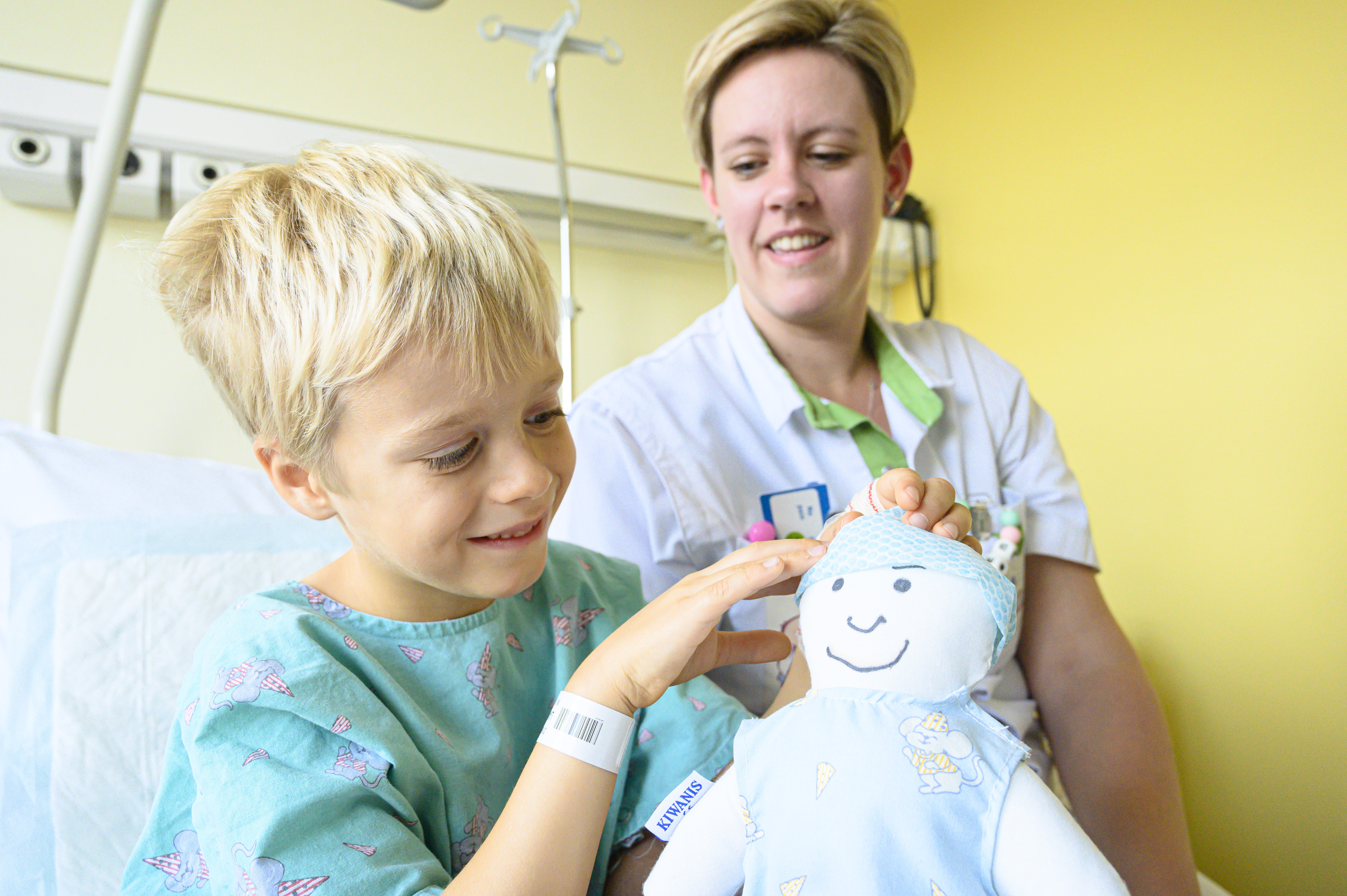
Paediatric pH-metry
Please note
The info on this page only applies to patients and treatments at St Vincent General Hospital in Deinze.
What is pH-metry?
What is pH-metry?In pH-metry, we measure the acidity in your child's oesophagus. We also check for reflux of stomach acid into the oesophagus. The heartburn, when it recurs for a long time and frequently, can inflame the oesophagus from the stomach. This initially causes your child pain during acid regurgitation, but later also pain during swallowing.
Indications for pH-metry
Indications for pH-metryChildren, and especially babies, easily suffer from too much reflux of acidic stomach contents into the oesophagus (= reflux). Sometimes this is easy to notice because the child regularly gulps or vomits. In other cases, one can only suspect it, e.g. if the child cries a lot or has persistent respiratory problems.
Course of the procedure
Course of the procedureTo measure the acidity in your child's oesophagus, we place a probe into the lower part of the oesophagus. This probe is inserted through the nose. Inserting the probe is not painful, but it is briefly unpleasant.
Are you pregnant? Always report this as the X-rays can be harmful to the unborn child.
After the probe has been placed by the nurses, an 'X-ray' at the radiology department will check that the probe is in the right place. After this check-up, your child will return to the paediatric ward and will be allowed to eat and drink again.
The probe is connected to a portable recording device, which records all the data. Once the probe is properly positioned, the nurse will start the pH-metry through the device. The pH-metry will now take place in hospital for 24 hours.
One parent (to avoid crowding in this department) may be present at all times when the probe is inserted and checked in the radiology department, to provide comfort if necessary.
As a parent, what can you do for a pH-metry test?
As a parent, what can you do for a pH-metry test?Before the procedure
- Bring your child in fasted
It is important that your child has stopped eating and drinking three hours before the tube is inserted. This is to prevent vomiting during insertion of the probe. In our department, it is customary to place the probe around 9.30am (for a 9am admission) or around 2pm (1.30pm admission), depending on the scheduled pH-metrics. It is then best to make sure your child does not eat and drink after 7am or 11.30am, respectively.
- Medication use
Is your child already taking acid-reducing medication? If so, consult the paediatrician beforehand to find out whether this medication may be continued or should be stopped.
If you take acid-reducing medication (eg. Zantac®, Ranitidine®, Omeprazole®) to your baby, you should tell the paediatrician or nurse during the admission. Also report when you last administered the medication.
During the procedure
- Positioning
During the pH-metry, your child's bed should be completely flat. Feel free to comfort your child and to pick it up if necessary.
- Observations
During the monitoring, it is important to interpret a lot of data on the device. You will get the necessary explanations when the measurement is started.
The probe is stuck to your child's cheek with adhesive plaster. If you notice that the adhesive plaster is in danger of coming off, feel free to notify the nurse.
- Measuring device
It is necessary to help ensure that the probe is not disconnected from the device and that the device does not get wet. To avoid these issues, a bath is given when the examination is over.
- Meals
The tube does not obstruct your child during meals. Your child can therefore eat as before during the hospitalisation, unless the physician makes changes. Note: during the examination, you should indicate when the child starts and stops eating.
Results of the examination
Results of the examinationpH <4 = reflux
During the measurement, the nurses will check the pH (acidity) at certain times. It is recommended not to focus on these results. The result of pH-metrics only becomes clear when its full course can be seen on the computer.
The nurses will stop the recording and remove the probe after 24 hours. Removing the probe only takes a few seconds. Your child may experience a prickling in the nose in this process, but is not in pain. The most unpleasant part is loosening the adhesive patch on the face.
The nurses will then put all the data stored in the device on the computer. Afterwards, the paediatrician will come and discuss the result with you.
Possible side effects
Possible side effects- Very rarely, throat irritation occurs after insertion of the probe.
- If your child is not fasted when it is inserted, it may vomit.
Do you have any questions?
Do you have any questions?Do you have any questions after reading this information? You can always contact your attending physician through the secretariat or a ward nurse: +32 (0)9 387 72 40.
Deinze - Paediatrics secretariat
Tel. +32 9 387 72 48
E-mail: secretariaat.pediatrie.deinze@mijnziekenhuis.be
Are you worried or do have questions about your child's admission? You can contact the nurse in the paediatrics secretariat during the day . Please ask the paediatrics secretariat your non-urgent questions by email or by phone.
| Monday | Tuesday | Wednesday | Thursday | Friday |
| 8am to 6pm | 8am to 6pm | 8am to 6pm | 8am to 6pm | 8am to 6pm |
If the secretariat is unable to help you, the paediatrics nurse at St Vincent General Hospital in Deinze can also advise you.
The nursing ward is accessible at any time.
Leaflet
LeafletDownload the leaflet on pH-metry for children here.
Something wrong or unclear on this page? Report it.



